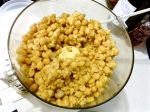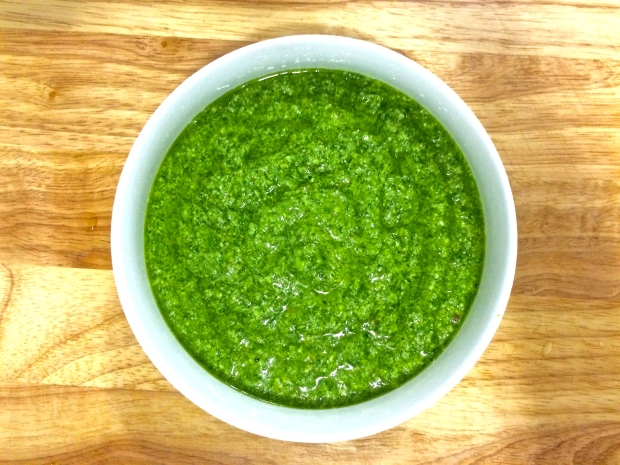
Summer is ending too soon. The weather is still warm, but college students are already filtering back into the city and the streets are starting to fill with people who have been out of town. Despite not having gotten away, this summer has been a great one. I’ve seen good friends and made a few new ones. I’ve eaten, drank, and danced. There have been rooftop parties, intimate dinners, and a lot of laughter. As a bonus, the weather has been unusually clement, so this summer has been a pleasure instead of a hot, sticky pain. All in all, it has been the best stay-cation that I could have asked for — and a sorely needed one at that.
Before work resumes and teaching takes over my life again, I want to fit in a few more blog posts, so …
Here is my write-up of this year’s Brooklyn Ice Cream Takedown and the recipe for my Mango-Lime-Tequila Sorbet with Mexican Chili Seasoning.
How did I come up with the idea?
In terms of flavors, I had two in mind: a tomato sorbet resembling frozen gazpacho, and a tart and juicy mango sorbet with limes and tequila.
I personally thought that a tomato sorbet would be amazing, but the general consensus was that it might be a little too weird for the competition.
My vision for a mango sorbet? I wanted it to taste just like those sliced mangoes topped with either hot sauce or dried Mexican chili seasoning. The kind that you get in plastic bags sold from pushcarts by those mango ladies in and around the city.
And that is exactly what I made 😀
Kitchen stories of triumph over adversity are terrific, but this is not one of those. This story is actually pretty humdrum because after the drama leading up to last year’s Brooklyn Ice Cream Takedown, I swore that I would never again:
 – Grossly underestimate how long it takes to prepare 2 gallons of ice cream at home.
– Grossly underestimate how long it takes to prepare 2 gallons of ice cream at home.
– Fail to read the directions accompanying any new equipment in advance.
– Not have enough equipment to begin with.
– Wait until the last minute to start recipe testing.
– Have no back-up plan in case my freezer doesn’t get cold enough and/or my air-conditioner stops working.
I am happy to report that I took all the lessons I learned last year and this year, I started and finished early with (almost) no tears and minimal stress! Hooray!
What I have learned since the 2013 Brooklyn Ice Cream Takedown:
1. Start early. Those stupid insulated bowls — which never really work that well to begin with — need at least 24 hours to freeze hard enough to churn your ice cream satisfactorily. So make room in your freezer, lower the temperature as much as you can, and park those things in the very back of it until they are frozen rock solid.
2. Buy all of your ingredients at the same time. Don’t wait. Don’t come back later. Just get them all when you see them. And buy enough to make an extra batch. Trust me. Once I had settled on a recipe and calculated how much I needed to buy in terms of ingredients, I realized that I would need 36-38 mangoes and about 80 limes. Does anyone want to haul home that much squishy fruit all at once without a car? No. What did I do? I only bought half of what I needed.
Can you guess what happened? When I went back to the store THEY WERE SOLD OUT OF THE COMPACT, SUPER SMOOTH, BUTTERY, FRAGRANT, AND AMBROSIAL CHAMPAGNE MANGOES FROM MEXICO THAT I WAS USING AND ALL THAT WAS LEFT WAS THOSE GIANT GREEN, RUBBERY, AND COMPARATIVELY FLAVORLESS KENT MANGOES.
I went to 4 different Whole Foods before finally being directed to one of the buyers who told me that, sadly, the season was over. There were no more Champagne mangoes.
As tears began to prickle the backs of my eyelids, I asked him if he could suggest another variety.
“Those Champagne mangoes,” he sighed and shook his head. His eyes went soft and dreamy, “You can make anything with those mangoes.”
He jabbed his finger towards the current display, “Not like these green rocks.”
This is one of those moments when I am so thankful that I live in New York. After calling almost every specialty fruit vendor in the city, I tracked down one of the last pallets in town.
Marry me, Manhattan Fruit Exchange.
3. K.I.S.S. Keep It Simple, Stupid. I agonized over this one after doing just one test run and loving the results. But a single test batch? Was it possible to find the one after just one try? There were a ton of super creative, delicious, and mind-blowing ice creams at the Takedown like Chicken and Waffles, Cherries and Sour Cream, Blueberry Pancakes with Hot Maple Syrup.
But I know my limitations and, more importantly, the limitations of my kitchen. I would have loved to have done a crazy flavor, but making it in a kitchen the size of a shoebox would have driven me crazy.
“Maybe it’s not wacky enough?” I asked myself.
Maybe that’s fine.
4. Use a stabilizer. Unless you are playing with liquid nitrogen, you will need something to smooth out the texture and prevent your ice cream or sorbet from having an icy or chalky mouthfeel. Stabilizers are additives to frozen treats that work to inhibit the formation of bigger ice crystals. Within that category, you can use guar gum or xanthan gum. However, a stabilizer does not necessarily need to be so exotic. You can use gelatin, alcohol, fat, sugar, and invert sugars such as glucose, honey, maple syrup, agave syrup, and corn syrup.
5. Ripe ripe, Baby. If you are making a fruit sorbet, you want your fruit to be very ripe — verging on overripe. How will you know if your fruit is ripe enough? It will feel like . . . well . . . let’s try to keep this forum as family-friendly as we can.
6. Strain. Evenly-textured ice cream and sorbet doesn’t just happen. Smooth base in = smoother frozen dessert out.
7. A watched ice cream maker never churns. Ari watched me swear and smack my stupid ice cream maker on the side after it failed to churn sorbet after . . . 5 minutes.
“Daisy, it says it will take ‘as little as 25 minutes’ on the box. It hasn’t been 25 minutes!”
She was right. Go, go watch an episode of 30 Rock and come back later.
8. So your ice cream maker fails to churn satisfactory frozen dessert and you have a slushie instead of a sorbet. This is what happens when your freezer bowl is not cold enough, your kitchen is too hot, or the freezer bowl is so overfilled that it loses chill faster than it can churn your ice cream or sorbet. This is when you get creative. This is when you let the ice cream set up more in the freezer, stick your handy stick immersion blender in it, and use it to break up the ice crystals before letting it freeze the rest of the way. Do this a few times as it continues to set up and you will be rewarded with some super smooth sorbet.
An important word on stick immersion blenders:
THEY LOOK INNOCUOUS, BUT THEY WILL MESS YOU UP IF YOU ARE NOT CAREFUL.
One only needs to google “immersion blender accidents” to be scared.
The worst kitchen accident that I have ever had did not involve an immersion blender (knock on wood). I had put a saucepan in a hot oven and after about an hour, I reached in, grabbed the handle and hefted it onto the stovetop. As I had been cooking all summer, I had “kitchen hands,” tough, calloused paws that didn’t register that the handle was over 350° until it was too late. I left some skin from my palm and my fingers on that handle. I spent the rest of the week with my hand in a tub of arnica cream.
In any case, when dealing with immersion blenders, TREAT THEM WITH RESPECT AND ALWAYS UNPLUG THEM WHEN THEY ARE NOT IN ACTIVE USE!
Although I realize that some of these pointers are most applicable if you are churning out a massive amount for something like an ice cream competition, I think that many of them are equally as valid for smaller batches
A word on the recipe that follows: What is that chili powder stuff on top?
Tajín is the brand name of a Mexican fruit seasoning consisting of only three ingredients, three flavors: a chili spice blend, salt, and dehydrated lime juice. As the components are few, I imagine that you could probably hack the recipe pretty easily using a basic Mexican chili spice blend, salt, and either dried, powdered lime zest or squeezing lime juice on top before serving. That being said, Tajín is so darn inexpensive (mine was $1.25) that it seems silly to hack it. I got mine at the Mexican supermarket, but I have also seen online forum posts about people seeing it at Walmart, Target, and at their neighborhood supermarket in the “Ethnic Foods” aisle. For a few bucks more, you can also score it on Amazon.
Of course, this sorbet tastes amazing without it, but the seasoning really does make a difference. It is definitely worth seeking out! You can also use it on just about any kind of fruit or vegetable (delicious on corn).
Another word on the recipe that follows: Why are there so many mangoes in the pictures?
As I have scaled the recipe down from the one that I used for the competition, you will see more fruit and more ingredients in the photos than are listed below. My competition recipe was for 2-quart batches and this scaled down recipe given will make a third of that. To make a full 2-quarts, simply triple the recipe. For example, instead of 2 mangoes, you will need 6, etc.
Ingredients:
2 very ripe Champagne mangoes
1/4 cup of water
1/2 cup of cane sugar
1 tablespoon of agave syrup
1 tablespoon of tequila (I used Olmeca Altos Plato)
1/2 cup of freshly squeezed lime juice (from about 4-5 limes), strained
Tajín Clásico Seasoning
How to prepare:
1. Gently peel the mangoes with a sharp paring knife and cut the flesh away from the pit. Do this in a bowl so you don’t lose any of the precious juice.
2. Purée the mangoes with 1/4 cup of water in a blender or using an stick immersion blender. Press the purée through a fine-mesh sieve with a silicon or flexible plastic spatula. Discard the solids.
3. In a large bowl, combine the mango purée with the cane sugar, agave syrup, tequila, and strained lime juice. Stir until the sugar has completely dissolved.
4. Churn the mango sorbet mixture in your ice cream maker according to the manufacturer’s instructions. If your sorbet fails to set up properly, churn it as best as you can in the machine, transfer it to a sturdy container, and let it harden in the freezer. After 45 minutes, use an immersion blender to blend the sorbet and break up any larger ice crystals. You can do this a few times to ensure that you have a really nice texture. When the mixture is smooth, return it to the freezer to harden completely.
5. To serve, scoop the mango sorbet into bowls and sprinkle liberally with Tajín.
 This blog post is another contribution to the Genie De Wit’s Our Growing Edge. Our Growing Edge is a monthly event that aims to connect food bloggers, broaden our horizons, and encourage us to try new things. I am so happy to see Genie’s project grow and reach a larger and larger audience of bloggers and readers! Anyone can be a part of the party! For more information, please go to the page Genie has set up on her blog Bunny. Eats. Design.
This blog post is another contribution to the Genie De Wit’s Our Growing Edge. Our Growing Edge is a monthly event that aims to connect food bloggers, broaden our horizons, and encourage us to try new things. I am so happy to see Genie’s project grow and reach a larger and larger audience of bloggers and readers! Anyone can be a part of the party! For more information, please go to the page Genie has set up on her blog Bunny. Eats. Design.
This month’s host is Lindsey from Sneaks & Sweets. Thank you so much Lindsey! To take a look at the participating bloggers this month, click here.
 A couple of months after we started dating, Joel went on tour for about a week. For that trip, I packed up a large picnic basket of home-made treats for him, his bandmate, and his former bandmate to eat on the road.
A couple of months after we started dating, Joel went on tour for about a week. For that trip, I packed up a large picnic basket of home-made treats for him, his bandmate, and his former bandmate to eat on the road.












































































